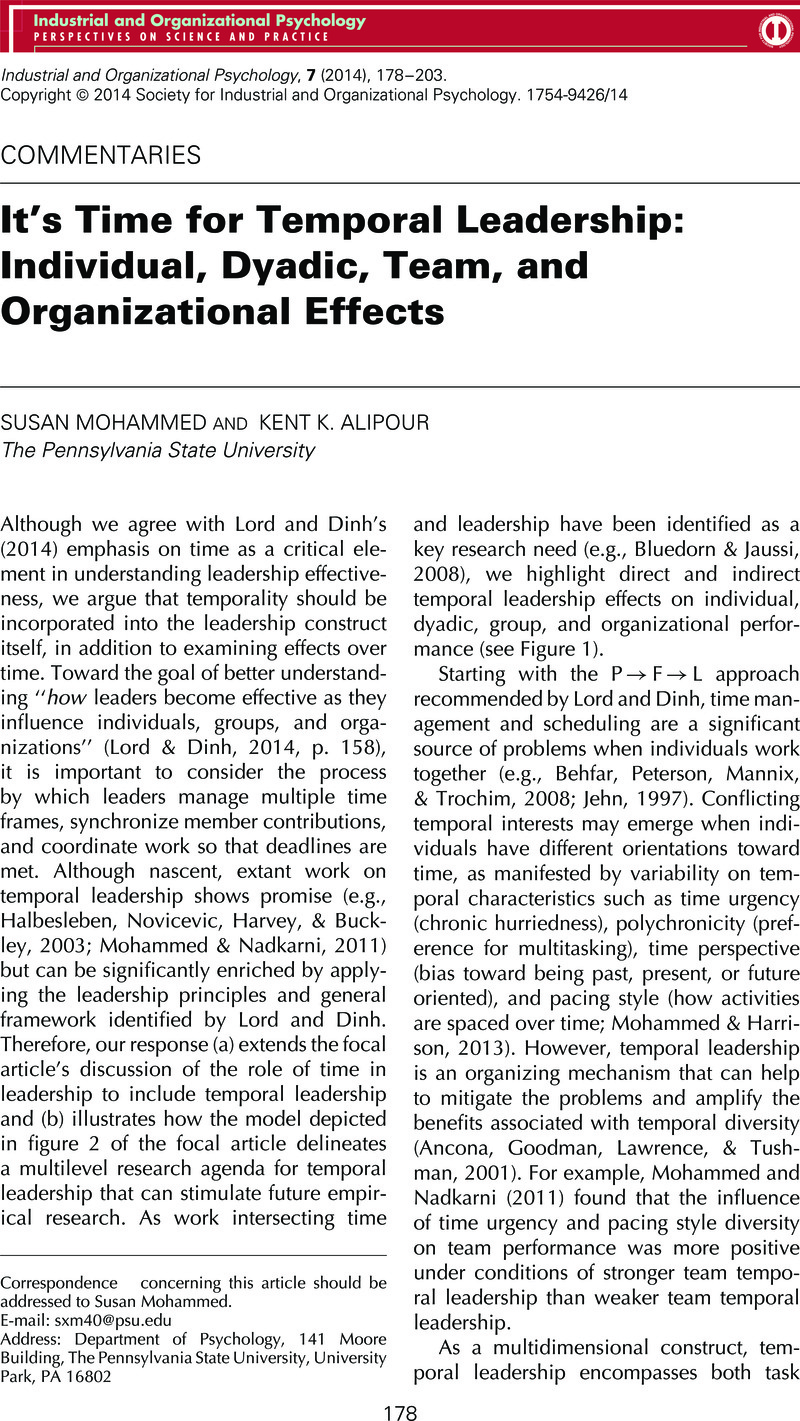Crossref Citations
This article has been cited by the following publications. This list is generated based on data provided by Crossref.
Santos, Catarina Marques
Passos, Ana Margarida
Uitdewilligen, Sjir
and
Nübold, Annika
2016.
Shared temporal cognitions as substitute for temporal leadership: An analysis of their effects on temporal conflict and team performance.
The Leadership Quarterly,
Vol. 27,
Issue. 4,
p.
574.
Sharma, Anshu
and
Bhatnagar, Jyotsna
2017.
Emergence of team engagement under time pressure: role of team leader and team climate.
Team Performance Management: An International Journal,
Vol. 23,
Issue. 3,
p.
171.
Alipour, Kent K.
Mohammed, Susan
and
Martinez, Patricia N.
2017.
Incorporating temporality into implicit leadership and followership theories: Exploring inconsistencies between time-based expectations and actual behaviors.
The Leadership Quarterly,
Vol. 28,
Issue. 2,
p.
300.
Najam, Usama
Inam, Aneeq
Awan, Hayat Muhammad
and
Abbas, Muhammad
2018.
The Interactive Role of Temporal Team Leadership in the Telecom Sector of Pakistan: Utilizing Temporal Diversity for Sustainable Knowledge Sharing.
Sustainability,
Vol. 10,
Issue. 5,
p.
1309.
Chen, Jiawen
and
Liu, Linlin
2020.
Reconciling temporal conflicts in innovation ambidexterity: the role of TMT temporal leadership.
Journal of Knowledge Management,
Vol. 24,
Issue. 8,
p.
1899.
Mahmood, Asif
and
Arslan, Ahmad
2020.
Ahead of the Curve: Leveraging Antecedents of Corporate Entrepreneurship to Pull Off Competitive Advantage.
Frontiers in Psychology,
Vol. 11,
Issue. ,
Zhang, Juncheng
van Eerde, Wendelien
Gevers, Josette M.P.
and
Zhu, Weichun
2020.
How temporal leadership boosts employee innovative job performance.
European Journal of Innovation Management,
Vol. 24,
Issue. 1,
p.
23.
Li, Mingze
and
Ye, Huili
2021.
Temporal Leadership and Bootlegging Behavior of Employees: The Mediating Effect of Self-Efficacy.
Frontiers in Psychology,
Vol. 12,
Issue. ,
Majeed, Haleema
Kayani, Umar Nawaz
and
Haider, Syed Arslan
2021.
The Project Communication and Trust Nexus as an Antecedents of Project Success: Moderating Role of Authentic Leadership.
International Journal of Business Communication,
Liu, Zhengqiao
Liu, Xiliang
and
Zhang, Xianchun
2021.
How to Solve the Time Dilemma? The Influence of Team Temporal Leadership on Team Innovation Performance.
Frontiers in Psychology,
Vol. 12,
Issue. ,
Briker, Roman
Walter, Frank
and
Cole, Michael S.
2021.
Hurry up! The role of supervisors’ time urgency and self‐perceived status for autocratic leadership and subordinates’ well‐being.
Personnel Psychology,
Vol. 74,
Issue. 1,
p.
55.
Gao, YuanYuan
Huang, DanYang
Jiang, JinXin
and
Wang, WuLin
2022.
Influence of self-serving leadership on employees' helping behavior.
Social Behavior and Personality: an international journal,
Vol. 50,
Issue. 1,
p.
1.
Lyu, Bei
Liao, Xiaoyu
and
Yang, Yanchao
2022.
Relationships Between Temporal Leadership, Transactive Memory Systems and Team Innovation Performance.
Psychology Research and Behavior Management,
Vol. Volume 15,
Issue. ,
p.
2543.
Li, Mingze
Peng, Shuting
and
Liu, Liwen
2022.
How Do Team Cooperative Goals Influence Thriving at Work: The Mediating Role of Team Time Consensus.
International Journal of Environmental Research and Public Health,
Vol. 19,
Issue. 9,
p.
5431.
Malanchuk, Irina G.
2022.
Cognitive Mechanism of Temporal Transspective and Dynamics of Natural Cognitive Architectures Providing Speech Communication.
Procedia Computer Science,
Vol. 213,
Issue. ,
p.
307.
Zheng, Junwei
Gou, Xueqin
Griffin, Mark A.
Goh, Yang Miang
and
Xia, Nini
2022.
Temporal leadership, attentiveness, and safety behaviors: The moderating roles of abusive supervision and safety consciousness.
Safety Science,
Vol. 147,
Issue. ,
p.
105633.
Zhang, Yingying
Hu, Zhonghui
Tian, Siyu
Zhou, Chunyang
and
Ding, Yi
2022.
Trickle-down effects of temporal leadership: The roles of leadership perspective and identification with leader.
Frontiers in Psychology,
Vol. 13,
Issue. ,
Li, Kai
Zhu, Guiqin
and
Baker, Rogis
2022.
Promoting teaching innovation of Chinese public-school teachers by team temporal leadership: The mediation of job autonomy and the moderation of work stress.
PLOS ONE,
Vol. 17,
Issue. 7,
p.
e0271195.
Zhang, Juncheng
Zhang, Shuyu
Liu, Fang
and
Chen, Weiqi
2022.
Make Time for Employees to Be Sustainable: The Roles of Temporal Leadership, Employee Procrastination, and Organizational Time Norms.
Sustainability,
Vol. 14,
Issue. 14,
p.
8778.
Xiao, Huan
Zhang, Zhenduo
and
Zhang, Li
2022.
Is temporal leadership always beneficial? The role of job passion and synchrony preference.
Personnel Review,
Vol. 51,
Issue. 1,
p.
299.



